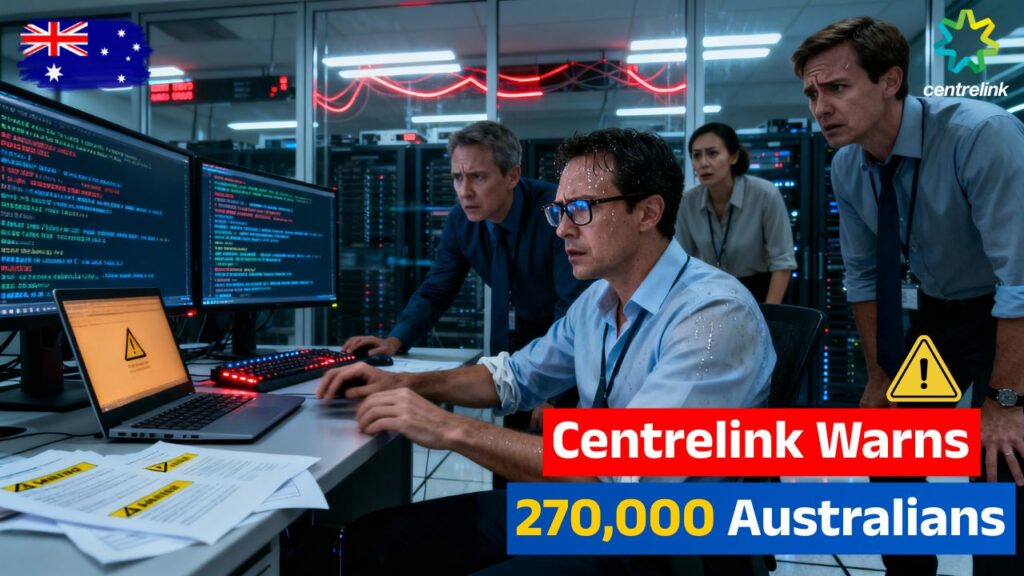Australians Email Attack – Centrelink has issued a major nationwide alert after more than 270,000 Australians were targeted in a sophisticated email attack linked to fake Medicare, superannuation and tax benefit updates. Scammers are impersonating official government portals and sending urgent messages designed to trick people into providing personal details or logging into fraudulent websites. This warning highlights the growing threat of digital fraud across Australia, especially as more residents rely on online Centrelink and MyGov services. Authorities are urging people to stay vigilant, verify every message, and know how to recognise official government communication.

Centrelink Scam Warning for Australian Citizens
The latest Centrelink scam warning has put Australian citizens on high alert after cybercriminals used convincing emails to mimic Medicare and tax-related updates. These emails often claim urgent action is required, such as “verify your benefits” or “update your super details,” encouraging recipients to click malicious links. Centrelink has clarified that it never asks users to confirm account details through email links. Australians are being advised to access their MyGov accounts only through official channels and avoid interacting with unexpected messages. By staying informed and cautious, citizens can significantly reduce the risk of falling victim to these ongoing digital threats.
 Australia Introduces $415 Rolling-Red Fine – AI Red-Light Cameras Now Catching Drivers Instantly
Australia Introduces $415 Rolling-Red Fine – AI Red-Light Cameras Now Catching Drivers Instantly
Email Attack Targeting Online Services Across Australia
The email attack targeting online services across Australia has become one of the most widespread phishing attempts linked to government benefits. The scam leverages familiar branding from Medicare, the ATO, and Centrelink to mislead users into thinking the messages are legitimate. Many messages falsely promise tax refunds, Medicare updates, or superannuation corrections to lure individuals into providing sensitive details. Cybersecurity teams have confirmed that these attacks are rapidly evolving, making it crucial for people to recognise warning signs such as spelling errors, unusual sender addresses, and embedded links. This nationwide alert aims to help Australians stay safe online while accessing important government services.
| Scam Indicator | What Australians Should Do |
|---|---|
| Unexpected Email Claiming “Account Update” | Log in directly via official MyGov site |
| Request for Personal or Banking Details | Never share information through email links |
| Threats of Account Suspension | Ignore and report message immediately |
| Fake Refund or Medicare Correction Alerts | Check ATO or Medicare through authenticated portals |
| Emails with Suspicious Attachments | Delete message without opening files |
Cybersecurity Measures Urged by the Canberra Government
The Canberra government is urging stronger cybersecurity habits among residents following this large-scale phishing outbreak. Officials emphasise that scammers often exploit high-traffic times, such as tax season or Medicare update cycles, to trick individuals into responding quickly. Australians are advised to enable multi-factor authentication on MyGov accounts, update passwords regularly, and avoid using public Wi-Fi when accessing sensitive information. The government also encourages reporting any suspicious emails to Scamwatch and the Australian Cyber Security Centre. These preventive measures can dramatically reduce successful attacks and help authorities track emerging threats.
Digital Safety Guidance for Australians
Digital safety has become a top priority for Australians as cybercriminals increasingly target government service users. People are encouraged to closely examine email senders, avoid clicking unsolicited links, and bookmark official Centrelink and Medicare login pages. The rise in scams tied to superannuation and tax benefits shows how criminals exploit financial stress and urgency. By staying informed, practising cautious online behaviour, and reporting suspicious activity, Australians can protect their identities and maintain secure access to essential services. Cyber experts continue to stress that awareness is the most powerful defence against these ongoing threats.
Frequently Asked Questions (FAQs)
 Centrelink’s November 2025 $250 Relief Payment – One-Off Boost for Age Pensioners Nationwide
Centrelink’s November 2025 $250 Relief Payment – One-Off Boost for Age Pensioners Nationwide
1. How do I know if a Centrelink email is fake?
A fake message usually contains unusual links, spelling errors or urgent threats demanding immediate action.
2. Does Centrelink ever ask for banking details via email?
No, Centrelink never requests sensitive banking or login information through email links.
3. What should I do if I clicked a suspicious link?
You should immediately change your MyGov password and report the incident to Scamwatch or the ACSC.
4. Can Medicare or ATO refunds be claimed through email?
No, all refunds or updates must be accessed securely through official government portals only.


